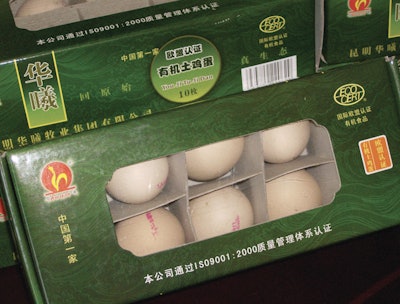
Blockchain technology may already be finding its way into the egg and broiler industries, but it was developed to control the trading of cryptocurrencies, such as Bitcoin. Each transaction - called a block - is digitally stored and, once completed, cannot be changed, making the risk of data modifications extremely unlikely. Blockchain is being widely promoted as a way of maintaining consumers’ trust in products and services.
Put simply, Blockchain is a database containing the history of all exchanges between stakeholders, with information visible to all parties involved throughout a value chain. When applied to the egg and poultry meat industries, Blockchain can be used to store information on products: their origin, how birds were farmed, or the type of feed provided. The technology is said to guarantee complete transparency on the route followed by products by creating a digital record to prove the provenance, authenticity, quality and type of production system used.
Early adopters
There are already a few documented cases of blockchain used in the poultry sector.
There was the well-reported example in 2018 of a small farmer in a remote village in a southern province of China selling, at a high premium on a popular e-Commerce platform, his free-range slow growing chickens, called GoGo Chickens.
In 2019, Carrefour, the French global retailer, launched its Blockchain initiative for one of its premium brands, the Auvergne chicken. Carrefour believes that consumers want more transparency and assurance about the products they buy. By scanning the QR code on the Auvergne chicken packaging, consumers can access, via a smartphone application, details about the product.
In 2020, a small-scale trial in the United States’ Midwest showed that Blockchain technology can also be applied to free-range eggs.
Some of the Blockchain benefits championed by retailers are transparency and traceability, which can help in building consumer confidence in terms of quality, authenticity and food safety.
But here is the catch. Are we doing all this only to ensure that consumes trust the food sector?
Any manual data entry could be a source of errors at best or a source of adulteration at worst. For Blockchain technology to work flawlessly, the entire value chain, from breeder farms and hatcheries, to farmers, egg packers and poultry processors, along with the entire distribution network all the way to the consumer, will need to be digitally connected and capture information via sensors and other internet of things devices. Its implementation will require a huge investment by farmers to digitalize all data collected on farms.
If, however, some stakeholders, upstream or downstream, along the value chain are not implementing Blockchain, farmers may be left with a meaningless investment in a new technology. While Blockchain’s benefits are more evident for producers of premium products, such as free-range or organic eggs and poultry products, it will be difficult to fully implement if of value to only some segments of the sector.
Digital technologies such as wireless sensors and probes combined with the unleashed power of artificial intelligence will soon offer great potential for efficiency gains and reductions in production costs. With a 24/7 presence on our farms, these new technologies will also enhance our ability to monitor bird health and welfare. While the egg and poultry sectors should embrace new technologies, adopting a new technology for the sole purpose of ensuring consumer confidence will be a sign of our inability to communicate. It is farmers themselves who must continue to be a reliable and trustworthy source of information about foods they produce.

















